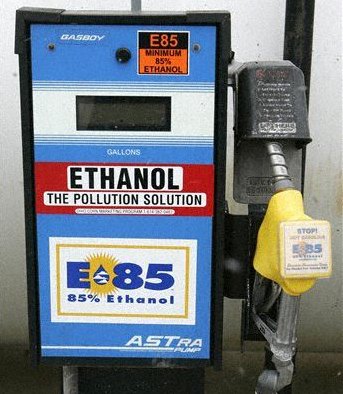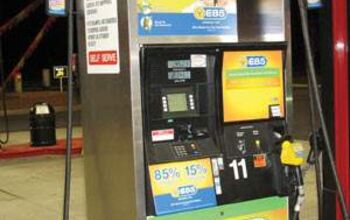E85: Children of the Corn?
First of all, corn farmers aren’t getting rich off of E85. America produces 11 billion bushels of the yellow foodstuff every year. More than half of the US corn crop goes to feed animals, mostly cattle and pigs. Much of the rest is used for corn syrup, oil, plastics and even heat. What’s left gets exported. The US ethanol industry’s growing appetite for corn has reduced our exports somewhat, but there’s still plenty left over after we’ve exhausted every possible domestic use. So corn prices remain low.
Or high. Despite the over-abundance of American corn, the US federal government subsidizes the price— paying farmers the difference between the crop’s fair market value and $2.50 a bushel. This price support ensures that corn farming remains profitable, so the US doesn’t have to buy corn on the global market. You might think the federal subsidy would assure profits for farmers and low input costs for ethanol producers, but you’d be wrong. Enter the middleman…
Unlike sugar cane (the source for Brazil’s ethanol), corn is a seasonal crop. Corn is also expensive to transport, making it difficult for farmers to sell directly to distant buyers. At the same time, most corn farmers lack the storage capacity needed to stockpile their Biblically bounteous harvest. No surprise then, that there’s an entire industry devoted to buying grain from farmers, storing it and shipping it to other buyers.
Obviously, there’s a nice little price bump involved. Grain middlemen seldom pay more than about $2 per bushel to buy corn; they can then get $2.50 to $3 for that same bushel on a futures contract. Ethanol plants are even willing to pay a little more, since they know they’ll sell every drop of fuel they produce. The upshot of all this agricultural to-ing and fro-ing: ethanol producers are stuck with a raw material cost that rarely drops below $2.50 a bushel, no matter how much corn is grown, stored or shipped.
Thus, a gallon of ethanol requires roughly $.75 of corn. That may seem like a compelling cost structure for an alternative fuel– especially when compared to this week’s crude oil price of $1.40 per gallon. But E85’s ancillary costs are far higher. First, ethanol is more expensive to produce than gasoline (i.e. it takes more energy to make fuel from corn than oil, and energy ain’t cheap). Second, thanks to the phaseout of octane-enhancing MBTE gasoline additive, demand for ethanol far exceeds supply. Third, ethanol’s transportation costs are astronomical.
Unlike petroleum-based gasoline, ethanol is too corrosive for existing pipelines. That means E85 has to be transported by truck or train. Unfortunately, America’s trains are busy hauling billions of tons of coal from mines to power plants. The railroads are adding locomotives as fast as manufacturers can build them (bet GM’s sorry they sold their locomotive business), but they’re all dedicated to moving a material that provides a larger, steadier business that's less hazards than schlepping ethanol. So, for now, E85 distribution is pretty much restricted to trucks.
The bottom line is clear: E85 production is dependent on a crop whose costs are more or less fixed at a permanently high level. E85 may be eco-sexy and an all-American source of fuel (provided you discount the petrochemical products used to fertilize and insect-proof the corn crop and power the vehicles that harvest, process and haul the corn around), but its current production costs make it an economically dubious alternative to “cheap” gas. And that’s without considering the fact that E85 yields about 20% less “bang for the buck” than gas. Unless the price of gas soars another dollar or so, or increased supply drops the price of ethanol by a like amount, E85 will struggle to provide a cost-effective alternative to its imported competition.
The fundamental economics of the E85 business ensure that the fuel is– and will remain– a product whose future depends more on politics than the “free market.” Of course, there’s nothing inherently wrong with that. If we’re serious about energy independence, the US government could intervene to make E85 more viable. Uncle Sam could build a national network of E85-compatible pipelines, or remove taxes from E85, or add taxes to gas, or end corn subsidies, or, well, lots of things. Meanwhile, the people who’ll benefit most from E85 are the people who move the raw materials to the ethanol plants and the finished product to the consumer.
More by Mark Hasty
Latest Car Reviews
Read moreLatest Product Reviews
Read moreRecent Comments
- Jrhurren Worked in Detroit 18 years, live 20 minutes away. Ren Cen is a gem, but a very terrible design inside. I’m surprised GM stuck it out as long as they did there.
- Carson D I thought that this was going to be a comparison of BFGoodrich's different truck tires.
- Tassos Jong-iL North Korea is saving pokemon cards and amibos to buy GM in 10 years, we hope.
- Formula m Same as Ford, withholding billions in development because they want to rearrange the furniture.
- EV-Guy I would care more about the Detroit downtown core. Who else would possibly be able to occupy this space? GM bought this complex - correct? If they can't fill it, how do they find tenants that can? Is the plan to just tear it down and sell to developers?


































Comments
Join the conversation
also Icenine and Martinjmpr back in July, Sugarcane can also be grown in Puerto Rico.